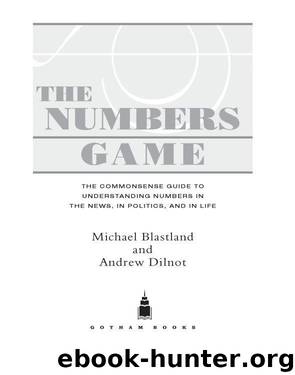The Numbers Game by Michael Blastland

Author:Michael Blastland
Language: eng
Format: epub
Publisher: Penguin Group US
Published: 2010-03-01T05:00:00+00:00
Don’t eat bacon. Just don’t. That’s not a “cut down” or a “limit your intake,” it’s a “no.” This is the advice of the American Institute for Cancer Research (AICR): avoid processed meat. “Avoid” means leave it alone, if at all possible.
The Institute says: “Research on processed meat shows cancer risk starts to increase with any portion.” And the Institute is right; this is what the research shows. A massive joint report in 2007 by the AICR and the World Cancer Research Fund found that an extra ounce of bacon a day increased the risk of colorectal cancer by 21 percent. A single sausage is just as dangerous.
You will sense that there is a “but” coming. Let it wait, and savor for a while the authority of the report, even if you can no longer savor a bacon sandwich, in the AICR’s own words:
“[The] Expert Report involved thousands of studies and hundreds of experts from around the world. First, a task force established a uniform and scientific method to collect the relevant evidence. Next, independent research teams from universities and research centers around the world collected all relevant literature on 17 different cancers, along with research on causes of obesity, cancer survivors and other reports on chronic diseases. In the final step, an independent panel of 21 world-renowned scientists assessed and evaluated the vast body of evidence.”
All this is true. As far as it is possible to discern the effect of one part of your diet, lifestyle, and environmental exposure from all the others, the evidence is not bad, and has been responsibly interpreted. So what’s the “but”?
The “but” is that nothing we have said so far gives you the single most essential piece of information, namely, what the risk actually is. We’ve told you how much it goes up, but not where it started, or where it finished. In the reporting of risk by the media and others, that absurd, witless practice is standard. Size matters to risk: big is often bad, small often isn’t—that’s the whole point of quantification. You want to know if the food on your plate is of the same order as Russian roulette, crossing the road, or breathing. It makes a difference, obviously, to whether you eat it. But in far too many reports, the risk itself is ignored.
Percentage changes depend entirely on where you start: double a risk of one in a million (risk up 100 percent!) and it becomes two in a million; put an extra bullet in the revolver and the risk of Russian roulette also doubles. But all the newspaper tells you is what the risk has gone up by (100 percent in both cases). By this standard, one risk apparently is no worse than the other.
This—you might think conspicuous—oversight is strangely (and in our view scandalously) typical. “Risk of X double for pregnant women” . . . “Drinking raises risk of Y” . . . “Cell-phone cancer risk up 50 percent.” You’ll be all too familiar with this type of headline, above reports that often as not ignore the baseline risk.
Download
This site does not store any files on its server. We only index and link to content provided by other sites. Please contact the content providers to delete copyright contents if any and email us, we'll remove relevant links or contents immediately.
| Anthropology | Archaeology |
| Philosophy | Politics & Government |
| Social Sciences | Sociology |
| Women's Studies |
Cecilia; Or, Memoirs of an Heiress — Volume 1 by Fanny Burney(32495)
Cecilia; Or, Memoirs of an Heiress — Volume 2 by Fanny Burney(31909)
Cecilia; Or, Memoirs of an Heiress — Volume 3 by Fanny Burney(31892)
The Great Music City by Andrea Baker(31756)
We're Going to Need More Wine by Gabrielle Union(19003)
All the Missing Girls by Megan Miranda(15774)
Pimp by Iceberg Slim(14433)
Bombshells: Glamour Girls of a Lifetime by Sullivan Steve(14020)
For the Love of Europe by Rick Steves(13558)
Talking to Strangers by Malcolm Gladwell(13290)
Norse Mythology by Gaiman Neil(13278)
Fifty Shades Freed by E L James(13186)
Mindhunter: Inside the FBI's Elite Serial Crime Unit by John E. Douglas & Mark Olshaker(9260)
Crazy Rich Asians by Kevin Kwan(9220)
The Lost Art of Listening by Michael P. Nichols(7453)
Enlightenment Now: The Case for Reason, Science, Humanism, and Progress by Steven Pinker(7272)
The Four Agreements by Don Miguel Ruiz(6698)
Bad Blood by John Carreyrou(6581)
Weapons of Math Destruction by Cathy O'Neil(6214)
